Moroccan argan oil: the ‘gold’ that grows on trees
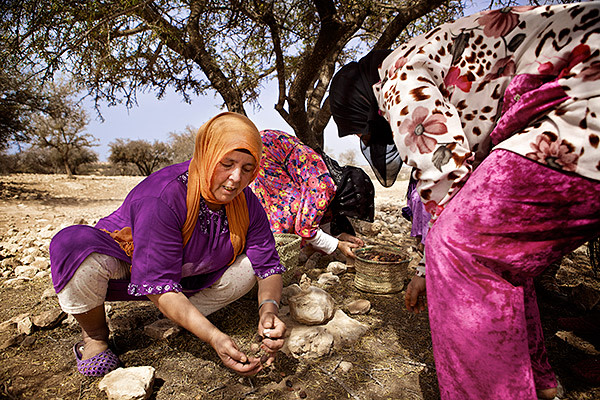
Simply sign up to the Life & Arts myFT Digest -- delivered directly to your inbox.
To take the road from Marrakech to Essaouira is to follow a horticultural timeline for Morocco. Leaving the city, with its citrus groves and date-palm plantations, some of which were first planted in the Almohad dynasty, the N8 highway streams west through sparsely vegetated flatlands. The high light levels and warm temperatures here have led to a growing industry supplying the insatiable demand of the international market for out-of-season crops.
Soon enough the landscape is littered with nurseries, most of them sprouting rows of polytunnels. Under the protection of these plastic-covered hoops grow salad crops, vegetables and tomatoes. It is an industry that has flourished since the early 1970s, from just 16 hectares of protected crops in 1975 to 16,500 hectares in 2006, much of it under the unnatural milky shrouds of thermal polyethylene.
A little under halfway into the journey the N8 drops south towards Agadir and the route to Essaouira continues on the slower, dustier route régionale 207. Somewhere between Ounagha and the Atlantic coast, trees begin to appear; solitary sentinels, then small groves giving way to more substantial plantings. These are argan trees (Argania spinosa); distinctively squat with a wide spreading canopy of small, leathery leaves interspersed with fearsome looking spines.
Argania spinosa is an ancient species; the lineage goes back to the Tertiary era, between 65m and 1.8m years ago. Endemic to the southwest of Morocco and the Tindouf region of Algeria, they thrive – perhaps a more accurate description is tenaciously survive – in calcareous soils in these semi-deserts.
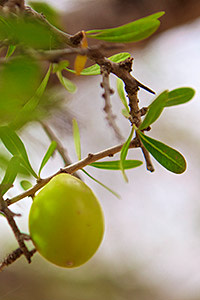
Despite the climatic challenges of their home range, argan trees manage to live for as much as 250 years. Their adaptations enable them to colonise the desert fringes where few other trees can grow, making them a vitally important bastion against desertification. They have long, questing root systems that go deep into the thin soil in search of the water table. The depth of the root system means the trees are firmly anchored to the ground and resistant to strong winds, which in turn protects the soil from erosion. Small leaves and tough stems help to reduce water loss caused by excessive transpiration.
The argan trees around Essaouira are frequently adorned with goats, which climb up into the tops of the trees and nimbly nibble the fruit from between the armoured branches. It makes for one of the most memorable rural scenes to be found anywhere, but historically the goats formed part of the production process of what the local Berber people consider to be arboricultural gold; argan oil.
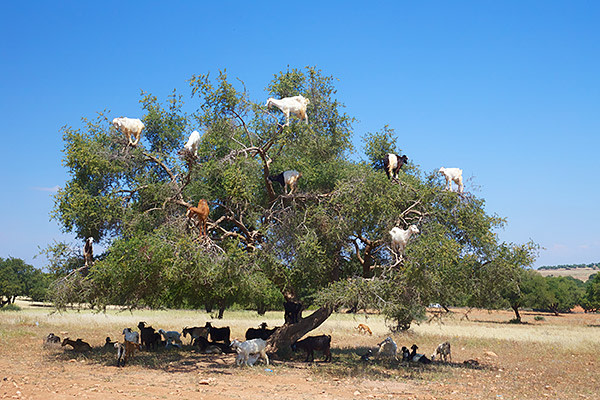
It takes argan trees at least 50 years to reach fruiting maturity. Inside the yellowy-green fleshy drupe is a kernel with a hard shell, and inside this is the “gold”; small seeds, between one and three per kernel, containing 60 per cent oil. Argan oil has been a component of Berber folk medicine for centuries, used in the treatment of skin conditions, rheumatism and heart disease, but in the past decade or so the cosmetic and food industries have woken up to its potential as an anti-ageing wonder treatment and super food. Argan oil contains 80 per cent unsaturated fatty acids, while laboratory testing has shown the oil to have antioxidant effects, neutralising free radical agents, protecting conjunctive tissue and restoring the skin’s water-lipid layer, lowering bad cholesterol and increasing good.

The growing interest in and demand for argan oil has exposed the continuing threats to the trees. Just as polytunnel-protected crop production was booming on the outskirts of Marrakech, the argan forest was declining. Through the 1970s and 1980s about 600 hectares per annum was lost. Trees were felled to make way for other crops, or cut down to be sold for wood turning and carving – the slow-growing timber is dense and finely figured. Deep ploughing for crop cultivation in and around the argan trees damages their root systems, leaving them more prone to drought stress and death. The newfound popularity of argan oil is having a deleterious impact too; the flow of extra cash has enabled the locals to buy more goats, resulting in more climbing and damage to the trees. Unesco recognition of the argan forests of southwest Morocco as biosphere reserves has not stopped the decline. The irony, of course, is that the further the argan forest retreats, the more the desert creeps forward, rendering the land useless for crops and exposing the soil to wind erosion.
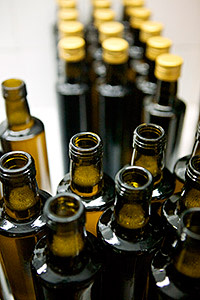
Extracting the oil from the drupes is a long and labour-intensive task that has traditionally been undertaken by Berber women; it takes 30kg of fruit and about 15 hours of labour to make one litre of oil. The fruits ripen and fall in late summer (they are never picked) and the dried husks removed. This is where, traditionally, the goats came in, digesting the husk and leaving behind clean kernels in their dung. This stage of production is now frequently bypassed – in food oil a “goaty” musk can occasionally be detected when it hasn’t – but much of the rest of production is unchanged. It is a process in which nothing goes to waste. In the goat-free method, the husk is allowed to dry out and is then removed and used as animal feed. The kernel is broken open by tapping between a large stone and a smaller handheld one, which is usually the worker’s own personal stone. The kernel shell can be ground down and is used in pottery production and for cosmetic skin exfoliants. The seeds are cold-pressed for cosmetic uses, or lightly toasted and pressed for food oil. The flavour is distinctive, rich and nutty, and has many uses, from salad dressing to flavouring porridge. The only thing it isn’t suitable for is cooking, as the oil cannot take heat.
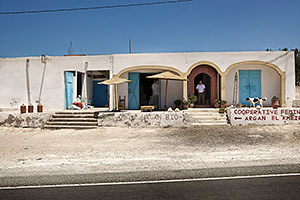
The expanding argan oil market has led to commercial growers outside Morocco taking an interest. There are now plantations of hybrid trees in Israel and the United Arab Emirates. It is in its home range where the value of the tree is greatest, both environmentally and socio-economically. Between 2m and 3m people rely on Argania spinosa as a source of income, the majority among the poorest Moroccan Berbers, and mostly women. The increased value of argan oil offers an opportunity to improve the lot of the people who rely on it, and at the same time encourage better custodianship of the forest by directly connecting quality of life to the value of the trees. In doing that, the argan forest will have the chance to do what it has done for centuries; stand firm against the creep of the desert beyond, and make gold from the dust.
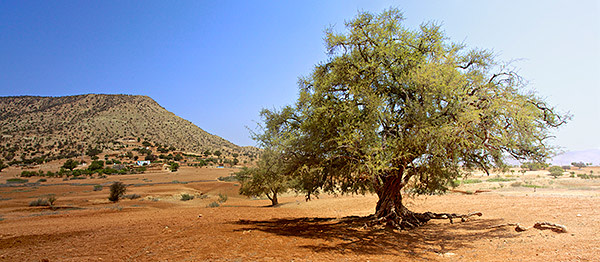
Matthew Wilson is managing director of Clifton Nurseries in London
——————————————-
Refining the oil industry
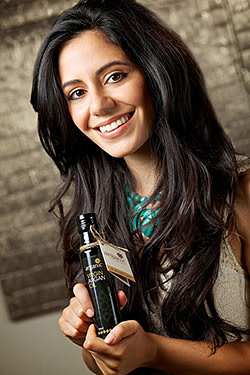
Dana Elemara, (right) was a young entrepreneur in search of a business opportunity when a relative mentioned the qualities of argan oil. The daughter of Iraqi parents, she spent a year on the Goldman Sachs graduate scheme but wanted to set up on her own, perhaps running a restaurant. Argan oil appealed because of its connections to health and beauty. Elemara researched the industry and found that the quality of the oil was hugely affected by the production processes. Poor hygiene and incorrect storage can cause the oil to spoil. Burning rather than toasting the seeds creates a bitter taste in food oils. Then there is the matter of authenticity. ”Double the amount of oil is exported from Morocco each year than the trees could actually produce,” says Elemara, suggesting that less scrupulous producers dilute the pure oil with cheap cooking oil.
Elemara used her savings to set up her business, Arganic, in 2012, going directly to a single supplier to ensure the oil was of consistent quality. The family-owned farm that supplies her has 600 Berber women on its books, and is working to improve conditions and remuneration, as well as modernising production processes. With a roughly 50-50 split between cosmetic products and food oil, Arganic now supplies shops in the UK and the Middle East, as well as top chefs such as Yotam Ottolenghi. ”It’s surreal to see my product in Selfridges,” says Elemara.
Photographs: Philipp Patrick Ammon; Getty
Comments